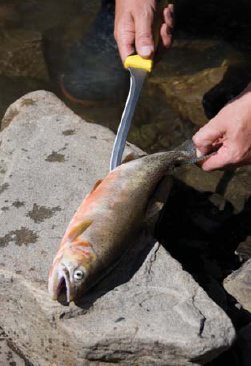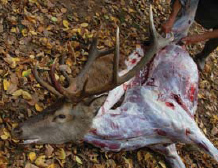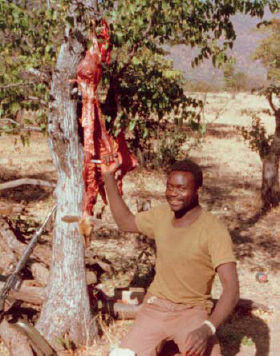Eating on the run
If you ever have to steal meat and run – say you were escaping from somewhere – kill the animal by cutting the carotid artery to the side of the neck and hack off one of the back legs. This is more meat than you will need. Stuff the leg down the front of your shirt to carry it. If you need to keep the meat for a while in a warm country cut it into strips like boot laces and hang it on bushes to dry. Dried raw meat is called ‘Jerky’ in some parts of the US and ‘Biltong’ in Africa. This way it will last for months rather like Parma Ham which the Italians prepare. It’s quite tasty and very nutritious – plus it gives you something to chew on so you feel you’ve had something.
COOKING IN THE STICKS
If you are eating ration packs then there is no need for a fire except to keep warm and raise morale if the tactical situation allows: you do make a marvellous target for a sniper huddled round a cooker or camp fire. Don’t cook at night – I would say ever but I know you will. Walk off a little way from a mate sitting over or by a fire/cooker and see what a good target he makes and then think about it. Sometimes you can dig a little hole to hide a cooker but it will still light up your face as you look over it if you aren’t very careful.
Given you are in a situation where you are cooking food you have stolen, bought or caught then you are likely on a Special Forces long duration mission and so you may also be building shelters. Where you put your fire relative to your shelter is quite important tactically and for getting the most warmth out of it so I will cover the cooking aspect of fire here and then its siting in the section on shelters.
Preparing fish for cooking
Fish can be eaten raw – few Westerners knew this before sushi became popular in recent years. Your body can get lots of nourishment out of fish without it being cooked but fish flesh can be full of worms and cooking kills these. A few worms in your belly for the length of a patrol will do no harm and they are easily removed with a de-worming pill when you get back to base. Just like you give the dog. Worms, contrary to urban myth, don’t make you thin by stealing a substantial part of your food. What they do is irritate your gut which can make you nauseous and so you eat less.

Gutting a fish is made easier with a decent knife. (i-Stock)
Cut off the head and tail of your fish. Save these for bait if required. Slice along the belly and drop out the guts. Cut further into the spine all along the length so the body can be opened out flat. Fish cooks quickly in any event but this flattening allows for even quicker cooking. You can cook over a fire by hanging the whole body lengthways along a stick. As an alternative you can fold the body back together and place on a hot rock or in ashes wrapped in a large leaf. The skin then holds the meat together a little. To pad out the meal chop the fish into pieces and boil with corn, veggies and curry in a pot. If you don’t have a fire then prepare the fish in the same way but dry it in the sun to keep for weeks.
Preparing meat
Meat can be eaten raw but it is more difficult to digest than fish and you will get more nourishment out of it if you cook it first. The heart, kidneys and liver of, say, an antelope are particularly good for you but check the liver does not have purple lines or other markings on it as that is a sign of liver fluke which is not good for you. Discard a liver with these signs and the remainder of the carcass is still fine to eat.

The first step to butchering a deer or large buck is to remove the skin from the entire body. (i-Stock)

Ace machine gunner and very passable butcher Musa prepares a gazelle I shot while on patrol. (Author’s Collection)
The most convenient, if not quickest, way to prepare a deer-type carcass is to make a cross-bar of a pole at a suitable height over a hole. Then you hang the dead animal by its back legs from the bar. First remove the head. If the animal is freshly killed the meat will last longer and eat better if you allow the blood to drain from the body before it has coagulated (i.e. gone thick). You may want to bake the head and extract the cooked brains as a treat. Or you may not.
Next remove the skin by making cuts around the ‘wrists’ of each limb. Continue each cut up the inside of the limb then join them with a cut along the belly which runs to the neck. Be very careful not to cut too deep as this will burst the membrane which holds the guts and result in their contents of shit and bile squirting everywhere with a foul smell which will taint the meat.
Tease a corner of the skin away from the flesh at the wrist and then peel it from the body all over. This is a lot easier to do than it sounds. Though the idea of keeping the skin as a souvenir may appeal to some, it needs treatment to stop it rotting or going stiff as a board when dry.
Now, very carefully, cut from the anus to the throat going just deep enough to cause the body cavity to open up but not deep enough to open the intestines as mentioned above. At this point the guts will start to come out of the body and should be allowed to drop into the hole provided for this purpose. You will have to release them from the body at one or two places including the anus and the diaphragm. When this has been accomplished you will have a nice, blood-free carcass ready to be cut into pieces for cooking.
Take off the legs first by cutting a circle around the top of each then carefully finding the ligaments which hold the joint in place and cutting them. There are a whole range of ways to dissect the remaining body depending on what you want to do with it. The meat running along either side of the spine is the fillet and a favourite cut.
A sizeable animal not only produces rather a lot of meat but the meat is in large, thick pieces and so takes a long time to cook. If there is more meat than you will eat in a day or two then, if the tactical situation and weather allows, you can preserve it by cutting into thin strips and drying on hot rocks or bushes in the sun.
There are many ways of cooking meat with a fire but small pieces on sticks, or larger pieces buried with hot rocks are convenient if you are short of equipment. Probably the least wasteful method though is to cut the meat into inch-thick cubes and boil in a pot with water and vegetables.
TOP TIP!
Dealing with your waste
Bury your waste deeply as the local wildlife will want to check it out for leftovers and depending where you are this may be a problem. Also, rotting food will attract even more flies than your usual allocation.
Cooking support
There are two easy ways to make a support for your cooking pot if the local vegetation allows: a tripod over the fire with a thinner stem hanging down and using a side-shoot from that as an adjustable hook is the best. Failing that one pole hanging at an angle over the fire wedged at the ground end with stones works well enough.
Brewing tea and coffee
A regular supply of tea or coffee, depending on where you come from, does wonders for morale in uncomfortable postings or positions. As an officer or NCO it is a good idea to ensure the men get a brew at regular intervals when in a static position. On patrols even, a brew at a break helps the day pass a lot easier – we are not trying to make life hard work after all.
CLOTHING
What do you wear clothes for? OK, I know, you don’t want to frighten the ladies. There are several other reasons you might want to wear clothes on operations – these are to keep warm, keep the sun off, stay dry and not be seen.